This was the favorite dish of renowned Jazz legend,
Louis
Armstrong (a/k/a "Satchmo"). He purportedly used
to sign his autographs "Red Beans & Ricely Yours!" May he rest in peace.
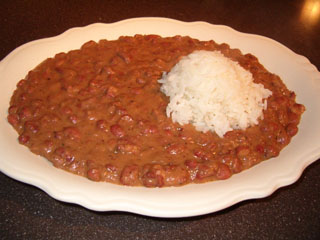
Ingredients:
1 fresh ham bone (using a cooked bone from a ham dinner
is the norm, especially one with plenty of meat still left on it)
1 lb. (457.6 g) dried red beans (the smaller kind - see notes below)
1 large yellow onion, minced
1 cup (226.8 g) green onions (tops & bottoms), finely chopped/minced
½ cup (113.4 g) green bell pepper, finely chopped/minced
3 - 4 fresh garlic cloves, crushed
½ cup (113.4 g)(one rib) celery, finely chopped/minced
¼ cup (56.7 g) fresh parsley, finely chopped
½ tsp. (2.39 g) dried basil
2 bay leaves
¼ cup (56.7 g) butter
salt, cayenne (red/hot) pepper to taste (I use plenty of each!)
~ Cooked, white rice ~
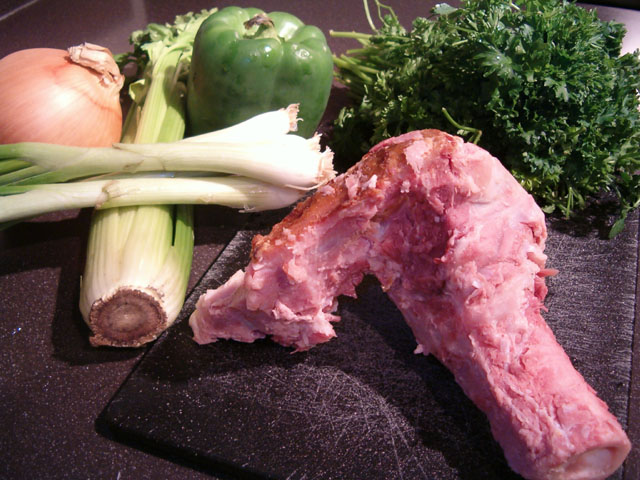
Save the bone from your Easter ham - it works great for this!
Preparation:
Pick through the beans, make sure to remove any bad/deformed
ones and rinse them well. Add the beans to two quarts (1.896 liters) cold water in a 4-quart (3.79-liter) pot.
Let them soak overnight. This prepares them for the long cooking time ahead. Alternatively (if you can't wait 'till
the next day), bring them to a boil and simmer two minutes; remove them from the heat, cover and let stand one
hour.
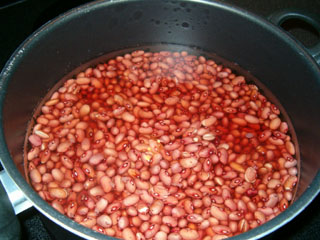
They say that soaking them for too long could cause some of
them to split open. In my experience, that always happens to some degree, regardless of how long they sit in the
water. But for this dish, it doesn't really matter, anyway.
Next, rinse the beans and discard the water that they
soaked in overnight, replacing it with another two quarts (1.896 liters) of fresh, cold water in which to continue
the cooking process. Bring the beans to a boil with the ham bone in the pot.
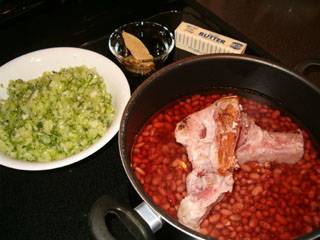
Once a boil is reached, turn down the heat to low, use
a pair of tongs to set the ham bone aside for a moment, add all the remaining ingredients except the salt to the
pot (adding the salt at this point would result in making the beans too tough on the outside), give it a good stir,
then put back the ham bone in the pot and insure that you submerge it as much as possible (some may stick up, but
that's Okay).
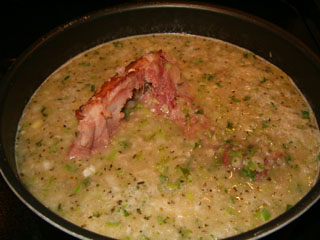
You won't believe how this changes in
appearance over the long cooking time!
Simmer uncovered on low heat (just enough to keep the
contents of the pot "percolating" at a nice, low bubbly boil) for four hours, stirring and turning the
ham bone every once in a while (I take it out after about 3½ hours). As it cooks, the nutrient-rich marrow
and most (if not all) of the meat from the ham bone will melt off into the pot, providing a nice, smoky layer of
texture and flavor to the dish!
Mash the beans up a little bit as it thickens, until you get a roughly creamed consistency a little coarser, but
thinner, than Mexican refried beans. Remove bone and the bay leaves, then mix in the salt.
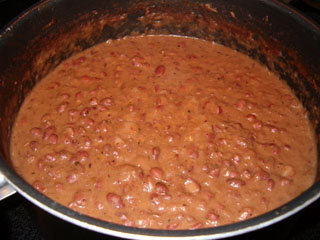
Four hours later - Can you believe it!?
Serve on a large plate with a heaping ladle of cooked,
white rice on top. Goes great with cooked, smoked sausages or a nice, grilled ham steak!
Makes 4 to 6 big helpings.
Notes:
In addition to chopping the vegetable components by
hand, I also then give them a quick whirl in a food processor before adding to the pot. That helps to reduce the
cooking time and to make the dish as smooth and creamy as tradition calls for.
The type of red bean we use is the small red bean (Mexican
red bean). These are similar to red kidney beans, only smaller, rounder, and darker. In the Southwest, they're
often used to make refried beans and chili. You may substitute any of the following, if you cannot find this kind
of bean: Pinto beans (good for making refried beans and chili), red kidney beans (they're larger, but they're good
for making red beans and rice) and azuki beans.

